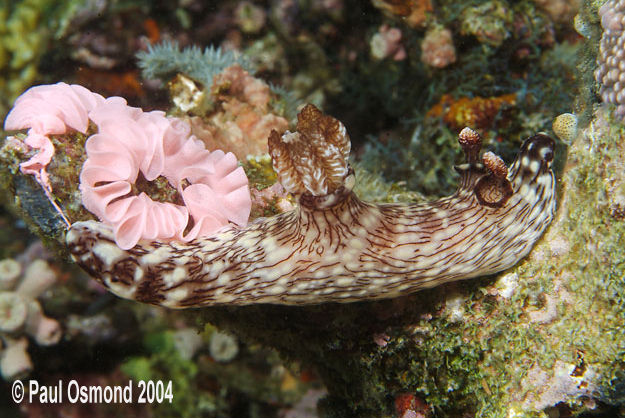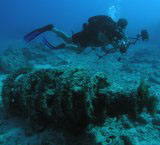 |
Jorunna rubescens
Digital Image
Photo courtesy of Paul Osmond
Anilao,Batangas, Philippines
Specimen estimated at 15cms in size at about 20m of depth
Jorunna rubescens Bergh, 1876 (Previously Kendrodoris rubescens)
This weeks BOW looks at a very strange looking dorid nudibranch which looks more like a Nembrotha or Polycera than a species of Jorunna. Until just recently (see Valdés & Gosliner, 2001), this species was assigned to the genus Kendrodoris. In this study Angel and Terry looked at the phylogenetic relationships of dorid genera in which the species bear caryophyllidia, that is spicules protruding from the notal papillae and tubercles. Based on the examination of the type species of all the described genera, they concluded that caryophyllidia-bearing dorids are a monophyletic group, and suggested generic synonymies amongst a number of caryophyllidia-bearing dorids. This work has important implications for nomenclature with some familiar names such as Kendrodoris disappearing. See the Sea Slug Forum for a list of these synonymies (just query synonymies in the search routine).
Jorunna rubescens has a strange body shape for a species belonging to the flat disk-shaped genera. It head is long and rounded like the front end of a B-52 bomber. The edge of the mantle seems to roll under hiding the hyponotum, and giving the appearance of a very thin foot. The gills emerge from a tall fluted swelling on the dorsum. It also has distinctive strange rhinophores. The clavus is a flat oval-shaped shaped structure, and the rhinophoral pocket has a raised collar. Color wise you can't really confuse it with any other species: the brown longitudinal lines are a giveaway. The amount of white and yellow found between these lines varies between specimens.
As seen in the Paul's photo here, the egg mass is a salmon pink color. The species occurs throughout the Indo-pacific and can get quite large reaching 20 cm in length.
Reference:
Valdés, A. & Gosliner, T. M. 2001. Systematics and phylogeny of the caryophyllidia-bearing dorids (Mollusca, Nudibranchia), with the description of a new genus and four new species from Indo-Pacific deep waters.Zoological Journal of the Linnean Society, 133: 103-198.
Danville, Calif
May, 2004

|
"Working for a international company allows me to travel internationally
and dive some of the worlds greatest dive destinations. I have been into
photography for many years and now run the
Deep Sea Images Stock Library .
I switched over to digital from film very early and was one of the first photographers to house the Fuji S2Pro DSLR camera. Currently the S2 is housed in an Aquatica housing and combined with either 2 Inon 220 strobes, a Inon 22 Ring Flash or a pair of Ikelite SS200's depending on the dive. Send Paul mail at marriard@deepseaimages.com |
WEBMASTER'S NOTES: Once again we have a outstanding image that amply demonstrates the "art form" that even photography of nudibranchs can transcend! Moreover, its digital with a rare display of the animal's egg mass! It's inspiring to the point that I want to jump back into the Philippine seas and try to do the same. It's been said over and over again, that to realize the full potential of your film or digital system, one has to throughly know the system!! So before you start throwing money at your system to realize better pictures, take a moment to re-read the manuals and do some experimentation. You might be pleasantly surprised!
Taxonomic information courtesy of:

David W. Behrens
Author:
Pacific Coast Nudibranchs
Send Dave mail at dave@seachallengers.com
|
